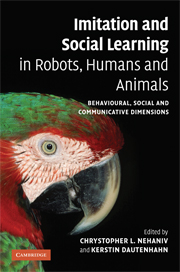 Imitation and Social Learning in Robots, Humans and Animals
Imitation and Social Learning in Robots, Humans and Animals Published online by Cambridge University Press: 10 December 2009
Introduction
Traditionally, robotics developed highly specific controllers for the robot to perform a specific set of tasks in highly constrained and deterministic environments. This required the embedding of the controller with an extensive knowledge of the robot's architecture and of its environment. It was soon clear that such an approach would not scale up for controlling robots with multiple degrees of freedom, working in highly variable environments, such as humanoid robots required to interact with humans in their daily environment. The field has now moved to developing more flexible and adaptive control systems, so that the robot would no longer be dedicated to a single task, and could be re-programmed in a fast and efficient manner, to match the end-user needs.
Robot learning by imitation, also referred to as robot programming by demonstration, explores novel means of implicitly teaching a robot new motor skills (Billard and Siegwart, 2004; Dillmann, 2004; Schaal et al., 2003). This field of research takes inspiration in a large and interdisciplinary body of literature on imitation learning, drawing from studies in psychology, ethology and the neurosciences (Demiris and Hayes, 2001; Billard and Hayes, 1999; Alissandrakis et al., 2002). To provide a robot with the ability to imitate is advantageous for at least two reasons: it provides a natural, user-friendly means of implicitly programming the robot; it constrains the search space of motor learning by showing possible and/or optimal solutions.
In this chapter, we explore the issue of recognizing, generalizing and reproducing arbitrary gesture (Billard et al., 2004).
To save this book to your Kindle, first ensure [email protected] is added to your Approved Personal Document E-mail List under your Personal Document Settings on the Manage Your Content and Devices page of your Amazon account. Then enter the ‘name’ part of your Kindle email address below. Find out more about saving to your Kindle.
Note you can select to save to either the @free.kindle.com or @kindle.com variations. ‘@free.kindle.com’ emails are free but can only be saved to your device when it is connected to wi-fi. ‘@kindle.com’ emails can be delivered even when you are not connected to wi-fi, but note that service fees apply.
Find out more about the Kindle Personal Document Service.
To save content items to your account, please confirm that you agree to abide by our usage policies. If this is the first time you use this feature, you will be asked to authorise Cambridge Core to connect with your account. Find out more about saving content to Dropbox.
To save content items to your account, please confirm that you agree to abide by our usage policies. If this is the first time you use this feature, you will be asked to authorise Cambridge Core to connect with your account. Find out more about saving content to Google Drive.